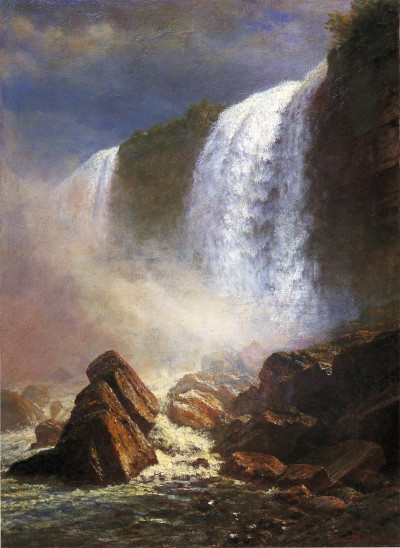Although there is not much information available on this painting, we can still summise much from the creator's time working in the region. Albert Bierstadt produced several different paintings of the Niagra Falls, and by placing them together we can understand more about his travels to this part of the US.
Falls of Niagara from Below specifies the particular angle from which this painting was made, and this helps to categorise the different works that he produced of the famous falls. This particular piece is around 92cm in height and 67cm in width but we could not find out where the painting currently resides, making it most likely to be somewhere within a private collection, probably still within the US. The artist loved the flow of water within his paintings and would travel to the coast many times in order to capture different islands and rock formations, as well as going in land along river routes in order to uncover more of these destinations. Drama was a key part of his style, although he did not always produce dramatic scenes, though the Niagra Falls were clearly suited to high levels of activity and so he chose to work in that manner whilst here. We do know that he regularly drew sketches initially, and then completed paintings from his studio and so it is highly unlikely that he actually created this painting from the position that we see in front of us here.
Bierstadt carried sketchbooks with him from which he could produce all manner of different drawings of his travels with the intended purpose of turning some of them into large paintings at a later date. He worked in this manner throughout his career and most landscape painters in Europe and the US would do similar. Travel was more cumbersome and harder to organise than it is today, meaning one would have to move around with as little baggage as possible. Bierstadt regularly went with others upon these journeys for the reasons of safety and enjoyment, with many of his colleagues not actually being artists themselves but more so just lovers of the wild outdoors. Bierstadt went on to create a good number of Niagra Falls paintings and by the time of this work was already highly skilled in capturing waves and water in a variety of different moods. He was known to romanticise his content, adding or amending items from reality in order to produce the best aesthetic possible.
Another artist who worked in a similar manner was Frederic Edwin Church, who produced related artworks such as Rainy Season in the Tropics, El Rio de Luz and The Aegean Sea. The two formed part of the highly respected American school which really pushed landscape art onwards, and also made a massive contribution to American art more generally. It was now becoming apparent that the US could create exciting art movements from scratch, rather than simply copying their Europeans counterparts, which had always been the case up to that point. Others would join these two and create a truly powerful body of work which helped an international audience learn more about the beauty of the American countryside, perhaps for some for the first time.




